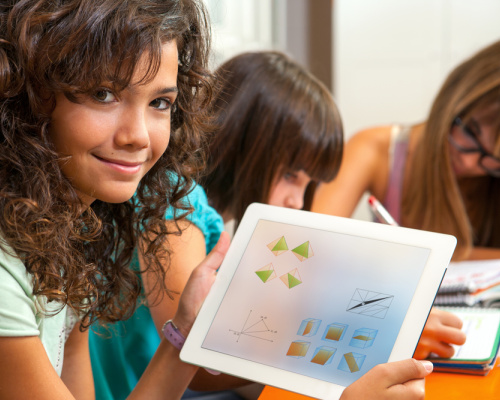Visual Math: How Virtual Manipulatives Take Learning Further
Date
While giant bins of brightly colored blocks, shapes, and counters used to be staples of every elementary classroom, today educators have increasingly shifted to a digital-first approach, and rely on virtual instead of physical manipulatives to help teach complex math topics through hands-on exploration.
Virtual manipulatives support student-led, personalized learning that is key to successful mathematical thinking and understanding. When they’re designed with intentionality and follow solid instructional design principles, they exemplify the sweet spot of digital pedagogy—using technology to provide enhanced learning experiences that would otherwise be unattainable.
Flexibility & Versatility
Teaching with virtual manipulatives gets to the root of what makes all hands-on learning with manipulatives so effective. Students can engage multiple senses while they manipulate and arrange objects to visualize an otherwise abstract math concept.
But where virtual manipulatives have a distinct advantage is in their flexibility and versatility. With a tap of a finger, dollars can be exchanged for coins. Clocks can be viewed with or without hands and numbers. A shape can be recolored, resized, and divided into any number of equal parts. Need more place counters? There’s no limit with a virtual manipulative.
This flexibility means that students aren’t limited to what they can see and do with physical manipulatives. Well-designed virtual manipulatives adapt, change, and work as fast as students’ minds do—putting all of the focus on the learning.
A Playground for Curiosity
With virtual manipulatives, students can play, experiment, and observe in real time how changing one variable affects another. They give students an interactive playground to chase their naturally curious wonderings.
A student might wonder, “If I double the width and double the height of this polygon, does that also double the area?” Spoiler: it doesn’t! “And what happens if I break apart this tens strip into single cubes?” Ah, that’s why borrowing works! This give-and-take interactive journey with real-time responses and instant feedback helps students to self-construct a deeper understanding of complex mathematical relationships.
Multiple Pathways for Diverse Learners
The Science of Math has shown that math instruction can be made more accessible and effective for diverse learners by incorporating strategies that use multiple representations, visual supports, and personalized learning approaches. It’s no coincidence these are the essential conditions of universal design for learning.
Virtual manipulatives effectively provide a visual and interactive approach to understanding math concepts that can easily adjust to meet individual learning needs. While one student may prefer to build with fraction bars, another may see fractions as shaded parts of a clock or maybe even jumps on a number line. Because they’re used as a tool for learning and problem solving, with infinite possibilities, virtual manipulatives work for students—reinforcing conceptual understanding while allowing for diverse pathways to get there.
Making Virtual Manipulatives Work
With the increasing prevalence of technology in education, it’s more important than ever to understand how digital tools and platforms can—and should—be used to effectively engage students and facilitate learning.
Like all digital tools in the classroom, the efficacy and impact of virtual manipulatives depends on good instructional design and a solid pedagogical foundation. Unfortunately, with little oversight, some virtual manipulatives available to educators online are little more than a substitute for rote memorization or passive engagement. It’s important to critically evaluate how (and if) the virtual manipulatives can offer an enhanced opportunity for learning and problem solving, and weigh that alongside the valuable tactile experiences afforded by physical manipulatives.
To be most effective, digital pedagogy needs its counterpart in real-world experiences. Having students stack their cubes, excitedly anticipate the outcome as their tower begins to sway, and then hear the satisfying clatter as the cubes come crashing down on the tabletop – there’s just no substitute for that! But virtual manipulatives allow for further discovery, to manipulate those cubes in ways not possible with physical manipulatives to explore more complex mathematical concepts in a digital space. Virtual manipulatives also allow for access outside of school, from almost any device. Being able to reinforce learning with further practice at home is a bonus.
With instructional design that offers flexibility and versatility, strong roots in research-based pedagogy, and a counterbalance with non-digital experiences, virtual manipulatives can offer an exciting avenue for exploring and understanding mathematics.
The Math Learning Center Apps
An example of effective virtual manipulatives are the collection we developed for The Math Learning Center. Each features a different visual model and provides a variety of ways for students to make sense of mathematical concepts. They have developed several examples of modeling math with these apps.
If you haven't considered the digital pedagogy of your product or service for educators, contact us for an initial consultation about how addressing this essential concept amplifies the effectiveness of your solution.

